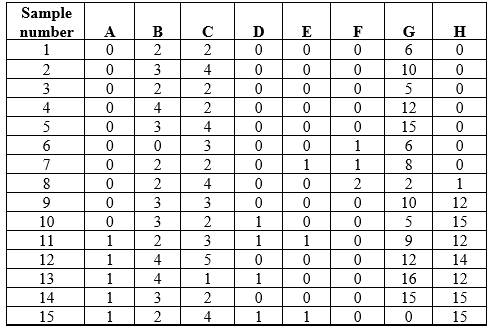Essay
Refer to the table.
Table 1
 Suppose you are researching an ecological community in a new study area. You divide your study area into quadrats and sample one quadrat a day to determine the species that occupy the area and how many individuals of these species are present. Assume that by the end of your sampling efforts, you have identified all of the species that occur in the study area. Table 1 shows the data collected for each sample for species A-H and indicates the number of individuals of each species identified in each quadrat. Use the table to investigate the pattern of species discoveries in your data. Then, create a new data table (this will be referred to as Table 2) that reflects the number of new species discovered as a function of the number of samples. Include the number of new species observed in each sample and the total number of species discovered over the course of your sampling.
Suppose you are researching an ecological community in a new study area. You divide your study area into quadrats and sample one quadrat a day to determine the species that occupy the area and how many individuals of these species are present. Assume that by the end of your sampling efforts, you have identified all of the species that occur in the study area. Table 1 shows the data collected for each sample for species A-H and indicates the number of individuals of each species identified in each quadrat. Use the table to investigate the pattern of species discoveries in your data. Then, create a new data table (this will be referred to as Table 2) that reflects the number of new species discovered as a function of the number of samples. Include the number of new species observed in each sample and the total number of species discovered over the course of your sampling.
Correct Answer:

Verified
Correct Answer:
Verified
Q38: The presence of a mutualist spider in
Q39: In the study by Jennifer Hughes and
Q40: Refer to the tables.<br><img src="https://d2lvgg3v3hfg70.cloudfront.net/TBO1115/.jpg" alt="Refer to
Q41: Members of the same functional group must
Q42: Despite having a relatively small biomass, populations
Q44: Steelhead fish are predators of predatory insects,
Q45: Refer to the figure.<br><img src="https://d2lvgg3v3hfg70.cloudfront.net/TBO1115/.jpg" alt="Refer to
Q46: Which statement describes a limitation of a
Q47: When wolves were returned to Yellowstone National
Q48: Species that feed on more than one